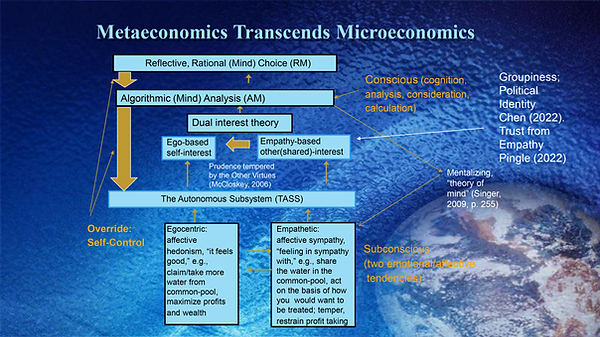
Underlying Behavioral and Neuroeconomics Science Sees the Dual Nature
Metaeconomics recognizes the key Neuroeconomics notion of the theory of mind as represented in mindfulness, being aware of what it might be like in the mind of the other. Empathy arises from putting oneself, in effect, into another’s mind (imagined, as it cannot be done as presumed in the interdependent utility and other-regarding notion), and trying to feel and think about what it might be like in the other person’s situation. The fact that mammals have the capacity for mindfulness on the way to empathy-with the other was found in the work suggesting mirror neurons, first discovered in the macaque monkeys (Singer, 2009, p. 255). It has since been found in many other mammals, especially in Humans. The following image depicts the behavioral science, the foundation upon which Dual Interest Theory is built (and, see Lynne 2020 for the details).
Starting with the Subsconscious, the Affective is represented in two parts described as the hedonistic and sympathetic tendencies. These operate primarily at a subconscious level. Consciousness can be described as an awareness of the two tendencies. We become aware we can look after only self, or, can also consider others part of our own internal self by projecting ourselves into the state of being of others, as described in the idea of empathy, i.e. “stand-in-their-shoes,” with the potential the individual will then become “in sympathy with” the shared cause, the shared ethic. Cognition, calculation and deliberation then enters to resolve the inherent conflict arising in these two passions/interests. This leads to the consideration of the two interests, and ways to fuse the inherent dichotomies across the two domains. Notice, also, the Arrows go both ways, as between the more conscious egocentric-empathetic level and more subconscious, affective hedonistic-sympathetic level.
Importantly, through rationally considering how to best balance the two interests, there is also a potential for a higher state of value, beyond price. In contrast to the saying that “Economists (neoclassical) know the price P of everything and the value V of nothing!” this framework proposes that Metaeconomists not only know the price of some things, but also see the value of most things. The notion of priceless makes full sense in dual interest theory.
This trajectory also recognizes that at times one or the other of the two paths may “trump” the other, perhaps even leading to “switching” in some cases, e.g. in the purchase of a recycle good (see Kalinowski, Lynne and Johnson, 2006). Also, this model sees the feedback that is ongoing from the running-on Automatic Choice (habits, customary ways to react, behave) to Rational Choice and back: The double pointed block arrows posit that the subconscious can be influenced, just as the subconscious continually influences, in fact is essential to, rational choice.
Important aside, related to stability or not in the political (economic) process, and the role of the subconscious: Changes in policy are largely about individuals joining into a new conversation once “shocked” out of the subconscious (invisible hand) into consciousness (visible hand) by becoming “irritated” that there is a problem. For example, people become irritated about the real possibility of running low on hydrocarbons, or there is excessive carbon dioxide releases causing global warming, or the lake is polluted, or, the community is in some sense deteriorating. This leads to cognitive consideration, to rational consideration and choice, especially in the domain of empathy-with the other. Such irritation is essential to change and action, in that most generally, there really are “walls” (thermodynamically speaking) and our business, industry, community, government leaders and agencies don’t see said walls. See Bromley (2006) on the role of shock and “irritation” in driving the policy process. Dual Interest Theory has a placeholder for such "irritation" and how it plays in rebalancing the pursuit of the joint self & other-interest, arising in the latter, as people find a new place for what the other can go along with. Policy changes accordingly, on the path back to political (ec0nomic) stability.
References
Bromley, D. W. Sufficient Reason: Volitional Pragmatism and the Meaning of Economic Institutions. Princeton, NJ: Princeton University Press, 2006.
Camerer, C., Loewenstein, G. and Prelec, D. “Neuroeconomics: How Neuroscience Can Inform Economics.” Journal of Economic Literature XLIII (March 2005): 9-64.
Chen, Yan. “Group Identity and Political Polarization.” Plenary Session, Herbert Simon Lecture, Society for the Advancement of Behavioral Economics conference, Lake Tahoe, Nevada, August 9, 2022.
Kalinowski, C.M., Lynne, G.D. and Johnson, B. 2006. "Recycling As a Reflection of Balanced Self-Interest: a Test of the Metaeconomics Approach." Environment and Behavior 38 (3):333 – 355.
McCloskey, D. The Bourgeois Virtues: Ethics for an Age of Commerce. Chicago, IL: University of Chicago Press, 2006.
Singer, T. “Understanding Others: Brain Mechanisms of Theory of Mind and Empathy.” In: Glimcher, P.W., Camerer, C.F., Fehr, E. and Poldrack, R.A (Eds.). Neuroeconomics: Decision Making and the Brain. New York, NY: Elsevier, 2009.